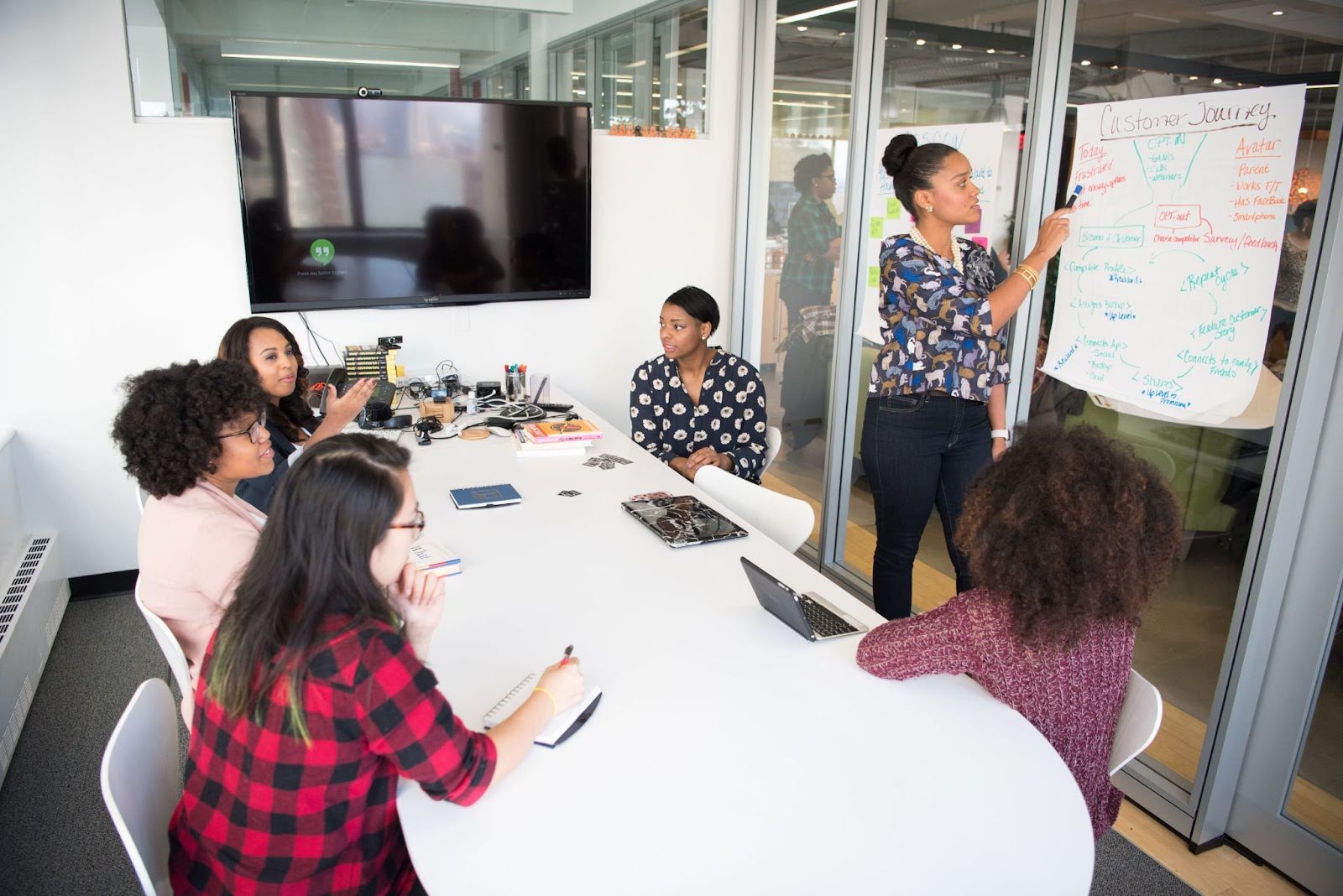Crafting a strategy to keep your employees happy and engaged can feel overwhelming.
Because in this fast-paced work environment, it’s not enough to have any old strategy. It has to be the right one.
Maybe you’ve noticed some hiccups in your current setup or sensed a gap in keeping your team fired up. Don’t worry, it happens to the best of us.
The thing is, having an employee engagement strategy isn’t a luxury—it’s a must-have tool in your business arsenal.
And you need one that fits your team like a glove.
Your plan needs to:
- Take into account the quirks of your workplace
- Build a vibe everyone loves
- And propel your crew toward success
So, let’s ditch the old employee experience strategies and work on the right one for your company.
What Is an Employee Experience Strategy?
An employee experience strategy (EES) is how you handle your workforce—the core plan on how you attract, nurture, and retain the top talent in your organization.
In the grand scheme of things, it keeps your company running smoothly. Without it, you risk friction, performance dips, and unnecessary roadblocks.
Intrigued? Let’s delve further.
5 Pillars of an Effective Employee Experience Strategy
Building an employee experience strategy that stands the test of time means understanding the vital pillars that hold it all together.
So, what are these pillars that you need to remember? Let’s find out.
Pillar #1: Company Culture
According to Forbes, a robust company culture helps businesses attract and retain talent
A robust culture goes beyond casual Fridays and office perks.
It’s about embodying values, fostering a sense of belonging, and creating a workplace where everyone is on the same page.
When your team believes in and lives your company culture, you’re not just colleagues. You’re working towards a common goal.
Pillar #2: Technology
In the era of digital dominance, technology isn’t just a tool anymore, it’s a necessity.
Employee digital experience is backbone that empowers your team to work smarter, not harder. It’s about adopting tools that don’t just keep up with the times but push your team to new heights.
That’s technology’s role in employee experience.
Pillar #3: Work Environment
Your work environment sets the stage for the daily act of creativity, collaboration, and productivity.
A thoughtfully designed environment speaks volumes about your commitment to your team’s well-being.
When your workplace is comfortable, inclusive, and tailored to your team’s needs, you’re creating the perfect backdrop for success.
Pillar #4: Leadership
Leadership isn’t just about steering the ship—it’s about being the wind in your team’s sails.
Strong leadership is empathetic, understanding, and sets the tone for the entire organization.
When leaders prioritize open communication, support professional growth, and lead by example, they create an atmosphere where everyone feels heard, valued, and motivated.
Pillar #5: Learning and Development
In a world that’s constantly evolving, a stagnant team won’t make it.
So, always provide opportunities for skill-building, offer mentorship programs, and watch your team flourish.
These pillars shape a workplace where talent chooses to stay and actively contributes to your organization’s success.
How to Design Your Perfect Employee Experience Strategy in 9 Steps
Creating a stellar employee experience strategy might seem like a daunting task, but with the right plan, you can make a great one.
So, here are ten detailed steps to guide you through the process, ensuring your strategy not only meets but exceeds your team’s expectations.
Step #1: Take Stock of Your Current Strategy
Let’s start with a deep dive into your current employee experience strategy. It’s time to assess the landscape and figure out what’s working and what needs a tune-up.
Begin by initiating a comprehensive assessment of your current strategy. Look at your existing programs, initiatives, and policies with a critical eye. This is about understanding the strengths and weaknesses of your current approach.
Evaluate the performance of your initiatives. Identify what’s delivering positive outcomes and where the pain points lie. This evaluation is a strategic move to uncover areas that demand attention and improvement.
The insights gained from this initial audit are your strategic assets. Recognize what’s functioning effectively and highlight areas that can benefit from enhancement. These insights will guide your way forward in refining your strategy.
Step #2: Identify Your Team’s Needs
Now, let’s shift our focus to understanding the unique needs and challenges of your team. It’s about becoming attuned to your team’s perspective and creating a strategy that resonates.
Engage with your team on a deeper level. Use tools like surveys, focus group discussions, or one-on-one conversations to understand their experiences. This is more than just data collection; it’s an active effort to comprehend your team’s dynamics.
Practice active listening during these interactions.
Your team’s input is a valuable resource. By actively seeking their perspectives, you’re gathering essential information to tailor your strategy according to their preferences and expectations.
Consider this gathered information as the foundation for customizing your strategy. This isn’t a generic approach; it’s about crafting a strategy that directly addresses the specific needs and preferences of your team.
Step #3: Set Clear Goals and Objectives
Now, let’s shift gears and focus on setting clear goals and objectives. This is about providing a roadmap that guides your strategy toward success.
Establish clear, actionable goals aligned with your overarching mission. Whether it’s enhancing engagement, reducing turnover, or fostering inclusivity, precision is key. These goals act as your guiding principles.
Ensure your goals are specific, measurable, and time-bound.
Clarity is essential—vague goals won’t cut it.
Make them measurable, so progress can be tracked, and set deadlines to create a sense of urgency.
Think of these goals as your roadmap. They provide direction and purpose to your strategy. With specific targets and deadlines, you’re not just working toward aspirations; you’re executing a well-defined plan.
Step #4: Align with Business Goals
Now, let’s talk about ensuring that your employee experience strategy and your business objectives are doing a perfect tango.
First things first, ensure your employee experience strategy aligns seamlessly with the grand plan of your organization.
Collaborate with key stakeholders and leadership – get in the room where the big decisions are made.
Open up those lines of communication. Collaborate with the movers and shakers in your organization. Dive deep into the company’s vision and mission. Understand the heartbeat of the business.
It’s not about just knowing; it’s about getting on the same page and crafting a strategy that’s in harmony with the organization’s broader goals.
Why does this alignment matter? Because a strategy that’s in sync with overall business goals is a strategy that contributes meaningfully to success.
Step #5: Map the Employee Journey
Now, let’s shift our focus to mapping the journey of your employees within the organization.
Consider the employee experience as a journey, spanning from recruitment to daily tasks and potential career advancements.
Think about a new employee at step one of this journey. Then walk with this hypothetical employee all the way through the onboarding journey, moving onto the team, and the weekly lifestyle of their job.
You do this to gain insights into the various touchpoints that define their experience within the organization.
Become a meticulous observer of this journey. Identify key touchpoints—those critical moments that significantly influence the employee experience. These touchpoints serve as landmarks, guiding you to areas that may require attention and improvement.
Mapping the employee journey is a strategic tool that allows you to pinpoint critical areas where improvements can be made.
Recognize the intersections where employee satisfaction might be impacted and focus efforts on creating a more seamless and positive overall experience.
Step #6: Prioritize Employee Well-Being
Shifting gears, let’s place a spotlight on the well-being of your employees—a fundamental aspect of organizational success.
Recognize and prioritize holistic well-being within your strategy. Prioritize initiatives that support mental and physical health, work-life balance, and the creation of a positive work environment.
Translate this commitment into actionable initiatives. Implement wellness programs that go beyond theoretical support.
Introduce flexible work arrangements that accommodate the diverse needs of your team. Foster a culture that actively promotes support and empathy.
Why is this crucial? Prioritizing employee well-being wins the affection of your employees—but also makes them more productive so that you can compete well in the marketplace.
Step #7: Encourage Professional Development
Invest in the growth and development of your team members.
Offer training programs that go beyond the mundane. Personalize employee growth paths because each employee has different goals.
This equips your workforce with skills that elevate their performance and contribute to the overall success of the organization.
Create a culture that values mentorship. Establish opportunities for seasoned professionals to guide and nurture the potential within your team.
This isn’t just about passing the torch; it’s about creating a network of support that fosters continuous learning and growth.
Outline clear pathways for career advancement. When employees see a well-defined route to progress, it becomes more than a job—it’s a career.
The payoff? When employees witness that their professional growth is not just encouraged but genuinely valued, it becomes a driving force for job satisfaction.
This satisfaction, in turn, breeds loyalty.
Step #8: Embrace Flexibility
Recognize the dynamic nature of the business landscape and build flexibility into your strategy.
Be prepared to adapt to changing circumstances, whether they be industry shifts, economic changes, or evolving employee needs.
A flexible strategy positions your organization to navigate challenges effectively and maintain resilience.
Step #9: Measure, Learn, Adapt
Implement measurable metrics to assess the success of your employee experience strategy.
Regularly collect and analyze data on employee satisfaction, engagement levels, and other relevant factors.
Use these insights to identify areas of improvement and make data-driven adjustments to your strategy.
Continuous measurement and adaptation are key to ensuring the long-term success of your employee experience initiatives.
With that being said, let’s discuss some tips to measure your employee experience strategy.
5 Tips to Measure Your Employee Experience Strategy
Developing an effective employee experience strategy is just the beginning; the real magic lies in measuring the impact of employee experience initiatives through right HR Metrics.
Here are five actionable tips to ensure your strategy is not just working but working wonders for your team.
Tip #1: Dive Into Employee Feedback
The frontline troops often have the most valuable insights.
Initiate regular surveys, conduct one-on-one check-ins, or host open forums to gather feedback directly from your employees.
Their thoughts and opinions are like gold dust, providing a real-time gauge of how your strategy is resonating on the ground.
Tip #2: Analyze Turnover Rates
Turnover rates speak volumes about companies.
High turnover can signal discontent or systemic issues, while low turnover might reveal areas where your strategy is hitting the mark.
Dive into the data, conduct exit interviews, and benchmark against industry standards to decode the turnover tale.
Tip #3: Track Performance Metrics
Numbers don’t lie, especially when it comes to performance metrics.
Regularly assess individual and team performance against set goals. Are employees hitting their targets, or are there consistent roadblocks?
These metrics provide tangible evidence of your strategy’s impact on productivity and overall performance.
Tip #4: Conduct Compliance Check
Compliance is the backbone of a robust HR strategy.
Regularly review your HR policies and procedures to ensure they align with current labor laws.
Provide ongoing training to your HR team to keep them well-versed in the ever-changing regulatory landscape. Periodic audits will guarantee your organization stays on the right side of the law.
Tip #5: Leverage HR Technology
In the digital age, your HR tech stack can give you advantages or disadvantages.
Evaluate the effectiveness of your current HR software and tools. Are they streamlining processes or causing headaches?
Explore emerging technologies that could enhance efficiency, from recruitment to performance management. Ensure your team is well-trained to harness the full potential of your tech investments.
Craft Your Winning Employee Experience Strategy
The hallmarks of an effective strategy set the stage for a thriving workplace.
The pillars—company culture, technology, work environment, and more—solidify the foundation, emphasizing why each aspect matters for a well-rounded strategy.
But the journey doesn’t end with implementation. To truly gauge success, we shared five tips to measure the impact of your strategy.
Now, it’s time to translate these insights into action, using the framework provided to craft your ideal employee engagement strategy.
Remember, it’s not just about creating a strategy; it’s about shaping an environment where your employees thrive.
As you create your winning employee experience strategy, consider taking the next step by getting our Employee Perks Report!
This report offers a side-by-side comparison of the savings provided by industry-leading discount providers, giving you an additional edge in enhancing your HR strategy.
Don’t just aim for a good workplace; aim for greatness. Start creating your winning employee experience strategy today.




